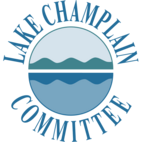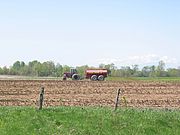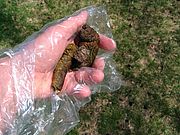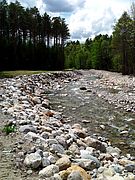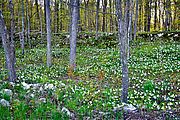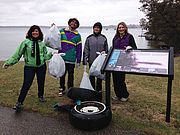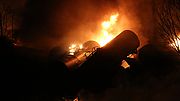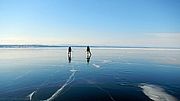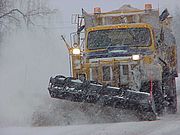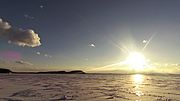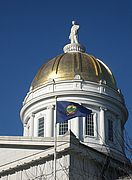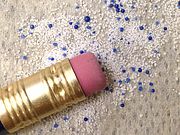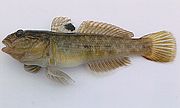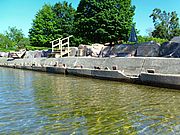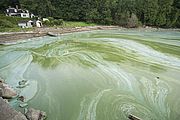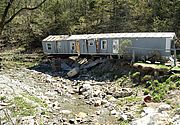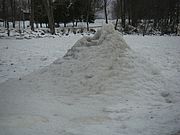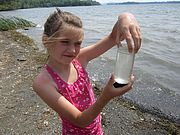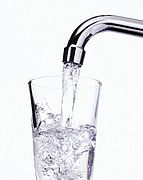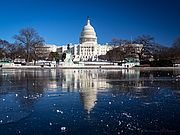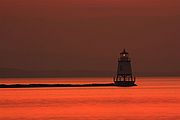LCC has received a grant from the Lake Champlain Basin Program to map and manage populations of floating leaved invasive plants, water chestnut and European frog-bit, in the northern portion of Lake Champlain. Read...
News from Selected Category
In the last few months courts in Washington State and Iowa have ruled that manure can be a pollutant. While many may see these decisions as obvious, manure has more frequently been considered a resource rather than a pollutant. In reality it can be both. Read...
There is no poop fairy. That’s the ingenious marketing message used around the Denver, CO area to nudge irresponsible pet owners to begin taking care of their dogs’ waste. Their public service announcement notes, "Like the Loch Ness Monster or Bigfoot, the fabled poop fairy has been the stuff of legend. Read...
Emergency actions alleviate immediate problems but can create long-term vulnerabilities. That happened in Rutland when flooding threatened the cities drinking water supply, but the quick work to protect it created vulnerability to future floods. Read...
April showers bring May flowers, or so the proverb goes. April on average is a wetter month than March, though not as wet as May. As sunlight strengthens in spring the air gets warmer, and there is an abundance of moisture in the form of snow and ice ready to evaporate and fall again as rain. However, it turns out this moisture may not be the most important factor in determining when spring flowers bloom. Read...
As the snow banks slowly recede they unveil the last five months’ detritus. From leaves to old newspapers to cans to dog waste to road sand, all of this will end up in the nearest stream without some help. It’s time for spring cleaning. Read...
Snowkiting on Lake Champlain, Water Pollution and Microbead Bans Signed into Law in New Jersey and Colorado. Read...
Two more fiery train derailments this month highlight the vulnerability of people, wildlife and waterways from the dramatic increase of crude oil transport by rail. The latest debacle has added pressure to improve rail transportation of flammable liquids. Read...
On February 20 in Montpelier the House Fish, Wildlife and Water Resources Committee recommended H. 35, the water quality bill by a vote of 7-2. The bill still needs approval from the Agriculture and Ways and Means Committees before heading to the House floor. Meanwhile a companion bill is wending its way through the Senate. Read...
The National Weather Service announced on Monday, February 16, 2015, that Lake Champlain is completely covered in ice. Remarkably, this is the second year in a row that the ice has extended over the entire lake surface (last year it closed February 12). Read...
Vermont Gas has halted work on a controversial proposal to supply natural gas to International Paper (IP) in Ticonderoga via a pipeline under Lake Champlain. Read...
It’s snow season. Diligent public works employees spend hours clearing snow and applying salt and sand to roads in order to make daily commutes safer. But eventually, when the snow melts, the sand and salt flows into that river and Lake Champlain. How does it affect water quality? Read...
The importance of agricultural tile drains as a contributor to water quality pollution is gaining more attention. In addition to its other provisions, the water quality bill recently passed by the House Fish, Wildlife and Water Resources Committee indicates some concern about agricultural tile draining. Read...
The layer of ice now sitting atop Lake Champlain insulates the water from the atmosphere and alters some of the physical phenomena that are sometimes seen around the lake. Read...
March 16-22 - Fix a Leak Week
More than one trillion gallons of water are lost annually in the U.S. due to easy-to-fix household leaks. Fix them during Fix a Leak Week!
LCC, the US Environmental Protection Agency and other WaterSense partners are promoting a week focused on water conservation. Wasting water wastes energy and money and can contribute <link lcc-at-work water-conservation _blank internal link in current>to lake pollution. Get a jump on the week by reviewing your water bills and seeing how much water you consume, then visit <link lcc-at-work water-conservation _blank internal link in current>LCC's Water Conservation page for <link lcc-at-work water-conservation water-conservation-tips-for-the-home _blank external link in new>additional water saving tips.
If your faucet drips or your toilet runs it can waste over 10,000 gallons a year -- the amount of water in a typical backyard swimming pool. Finding and fixing leaks around the home can be as simple as check, twist and replace.
· Check toilets - put a few drops of food coloring into the tank; wait a few minutes and see if the color appears in the bowl before you flush. If it does, there's a leak.
· Twist on aerators - add new WaterSense labeled faucet aerators and showerheads and tighten pipe and hose connections to save water.
· Replace leaking fixtures - be sure to choose WaterSense labeled fixtures when building or rennovating. They are independently certified to use 20 percent less water and perform as well or better than standard models.

March 17 - Clean Water Day
Come learn about water quality legislation pending in the Vermont Legislature and show your support for clean water at the Vermont state capitol in Montpelier. This program runs from 9:30 AM to noon in Room 11 of the Vermont State House. Hear about water quality priorities from Speaker of the House Shap Smith, get briefings on important bills moving through the Legislature, and connect with other citizens who care about clean waterways. Let legislators know you want to see action to protect water by coming to "the people's house" on St. Patrick's Day. Clean Water Day is sponsored by LCC, Vermont Conservation Voters, Vermont Natural Resources Council, Sierra Club Vermont, Toxics Action Center, and Watersheds United Vermont. To RSVP, email lcc@lakechamplaincommittee.org. Read...
Read more about Lake Champlain's threatened and endangered bird species, fishing regulation changes, replica boats, invasive species in the Adirondacks, erosion and more. Read...
Water quality improvements for Lake Champlain were a central theme when Vermont Governor Peter Shumlin stepped to the podium to deliver his inaugural address on January 8th. The Governor called for increased accountability for farm pollution and the establishment of a clean water fund that would provide increased funding for water quality projects. Read...
Earlier this week the Vermont House unanimously approved H.4, a bill to ban the manufacture and sale of harmful plastic microbeads from personal care products and over the counter drugs. These plastic beads are problematic because they wash down drains, slip through wastewater treatment plants and end up in our waterways. Read...
The spiny waterflea arrived in Lake Champlain last summer, becoming the 50th invasive species in the lake. We know it won’t be the last. Recently, a group of environmental professionals discussed what species posed the greatest risk of being the next arrival. Three likely candidates were round goby, hydrilla, and VHS. Read...
Since 2011 the region has made considerable investments in preparing for future floods. We all want to be more resilient when disasters like Tropical Storm Irene or the lake flooding of 2011 come about. Read...
Last August a blue-green algae bloom over the water treatment intake for Toledo, Ohio caused the city to test for the presence of microcystin, a toxin produced by some blue-green algae species. They found more than 1 part per billion of microcystin in the finished water, with concentrations peaking at about 2.5 parts per billion over the next two days. Read...
The flooding from Tropical Storm Irene made tangible the community costs that can occur when landowners develop floodplains. Homes and structures built too close to the water washed away becoming dangerous projectiles and in some cases damaging bridges or downstream properties. Read...
While skating along the flat clear ice of Mallets Bay four or five years ago, Jamie Leopold noticed a geyser of water shooting straight up into the air – 30 to 50 feet high. He may have witnessed a particularly large ice volcano. Read...
On January 21 a truck went through the ice on the banks of Fort Ticonderoga. Luckily both the driver and passenger made it out safely but the vehicle is at the bottom of the lake. It's now the driver's responsibility to get the truck out of the water or face a fine.
Read...Read more about algae blooms and nutrient levels, Wisconsin farms pollution reduction, manure in court rulings, how diabetes medication affects fish health, and more. Read...
Join the Lake Champlain Committee (LCC), Satellites, Weather and Climate (SWAC) and Champlain Basin Education Initiative (CBEI) partners as we consider how to structure investigations of the places we live using a variety of technology. Read...
Legislators in Vermont pondering how to fund Lake Champlain clean-up efforts might be encouraged by a new study coming out of the University of Vermont suggesting Vermonters are willing to put up some money. The average survey respondent was willing to pay $40 according to the study. Read...
If you have traveled outside the developed world you are probably aware that safe drinking water is not to be taken for granted. Tourists are routinely told to only drink bottled water or risk dysentery. Not so in the United States where all tap water in the country must meet rigid standards for contaminants. Read...
Key funding for Lake Champlain has been included in the comprehensive budget package passed by Congress last week. At the urging of Vermont Senator Patrick Leahy, the final budget includes a $3 million increase over last year for Lake Champlain through the Environmental Protection Agency’s (EPA) Geographic Program.
Read...In early December TDI New England filed a state permit application seeking approval for construction of a 154-mile underwater and underground transmission line that would deliver 1,000 MW of hydroelectricity to the Vermont and New England grid. Read...
